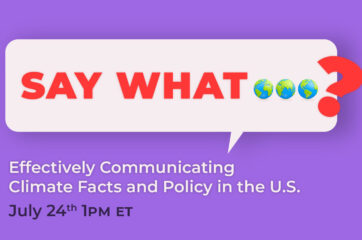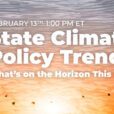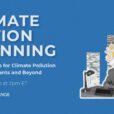As the coronavirus pandemic continues to take thousands of American lives, its effects are being worsened by a “heat dome” sitting over the continental U.S. As reported by the Washington Post, much of the U.S. experienced abnormally high temperatures throughout the month of July. Heat waves like the one we’re experiencing this summer form when air masses become stagnant over an area of land, allowing them to be heated to atypically high temperatures.
Pre-existing social and economic inequities are exacerbating the effects of both the pandemic and extreme heat on the most vulnerable Americans. This summer’s lethal combination of a pandemic, extreme weather, and inequality may prove to be a hard lesson in the importance of climate adaptation and mitigation, and of the need to base public policy on scientific facts, and system-level thinking.
How do the pandemic and heat wave impact each other?
This year’s heat wave threatens to accelerate the spread of the virus as people become more concentrated in air conditioned buildings or at public places, like beaches.
The pandemic is also restricting the ability of governments to respond adequately to the public health risks associated with extreme heat. Ever since the carnage brought on by a 1995 heat wave in Chicago, which took more than 700 lives, local governments have been painfully aware of the need to provide public access to air conditioning (AC) for low-income residents, or those experiencing homelessness, who otherwise would struggle to find ways to cool down.
However, social distancing restrictions during the pandemic are limiting the availability of this vital public service. WGBH reports that Boston’s public cooling centers will only be able to hold 40% of typical capacity in the coming weeks due to the need to prevent disease transmission. This means that those most vulnerable to heat might be unable to access the resources they need to stay healthy during extreme heat. These communities are often facing overlapping social and economic vulnerabilities, and are already disproportionately affected by a variety of other public and environmental health issues.
Research shows that Black and Latinx communities suffer from heightened average exposure to pollutants that worsen respiratory issues like asthma, and most recently, increased risks of COVID-19. Current economic conditions only make matters worse. At a time when unemployment is reaching levels not seen in decades, an economist at Columbia University has predicted that homelessness could spike by 45% this year.
How is this related to climate change?
It is widely understood that climate change is contributing to an increase in the frequency and intensity of heat waves.
A study by the Union of Concerned Scientists shows that in a high-emissions scenario specific to the U.S., climate models predict that the number of days each year with heat index over 37.8℃ (that’s 100.04℉) by the late 21st century will increase by four times, and days with heat index above 40.6℃ (105.08℉) will increase by eight times. This study also suggests that there will be far more instances of what scientists call “no analog” heat conditions, where temperature levels are reached that are currently unprecedented. Such conditions would occur at least once a year in 63% of the country by century’s end. By midcentury, the authors say that “the mean duration of the longest extreme heat event would be approximately double that of the historical baseline.”
Heat waves may not be the most visually dramatic natural disaster, but statistics show that heat is the deadliest weather-related disaster to humans. In fact, around 70,000 Europeans died due to extreme heat in the summer of 2003 alone. The World Health Organization reports that 166,000 people died from heat waves between 1998 and 2017, and the number of people exposed to heat waves grew by 125 million.
Policy Solutions
One of the most obvious implications of the increasing frequency of heat waves is that access to AC is becoming an even more important issue, particularly for the sick, the elderly, and infants (many of the same groups who suffer the greatest risk from COVID-19).
The issue of AC access intersects with a variety of socioeconomic factors. Homelessness is a huge risk factor when it comes to heat waves, because people with nowhere to go for air conditioning can be forced to spend dangerous amounts of time out in the heat.
Households that cannot afford AC, or the energy costs that come along with using it, are also at risk. Low-income individuals can be forced to choose between dangerous heat and higher utility bills that must be paid when the AC is turned on. This summer, many must cope with the added risk of exposure to disease if they leave the house to access cooling centers.
Fundamentally, inequitable access to AC is part of a larger issue of climate adaptation being far more difficult for people with existing, and often overlapping vulnerabilities. A recent study by the Climate Impact Lab highlights how economic and policy decisions are central to climate adaptation: according to the study, taking into account economic growth and climate adaptation decreases predicted deaths due to heat in 2099 by over 60% (good visualizations of the study results can be found at this Bloomberg article).
One way that American municipalities can prepare for a changing climate at the local level is to expand access to public locations that have AC. It is also crucial to have effective messaging to the public regarding where free AC can be accessed, as exemplified by this blog post at Curbed New York. Providing more and larger air conditioned spaces can also reduce the risk of disease transmission among those seeking shelter from the heat.
The growing need for AC also makes daily life more energy-intensive, which will further exacerbate the climate crisis as long as we remain dependent on fossil fuels for electricity. Increasing access to affordable clean electricity and energy-efficient technology can help circumvent this vicious cycle, and the resulting decrease in air pollution can also decrease susceptibility to respiratory illnesses like COVID-19.
Some of the policy tools that can help reduce the severity of heat waves are also good for the climate. For example, creating more green spaces in cities can reduce the urban heat island effect, thus decreasing the need for AC, while simultaneously increasing carbon uptake by plants.
This pandemic painfully illustrates that no person is an island. Everything we do, from international travel to a single cough, has countless downstream effects. If we are to continue living at a scale comparable in magnitude to the very forces of the Earth’s climate, then human flourishing will depend on our ability to align policy decisions with the uncompromising natural systems of which each one of us is but a small part.
We must do this with an emphasis on the most vulnerable, and a lens of equity. No economic, public health, or climate policy is adequate if it leaves behind the communities who are most impacted by these problems in the first place.









